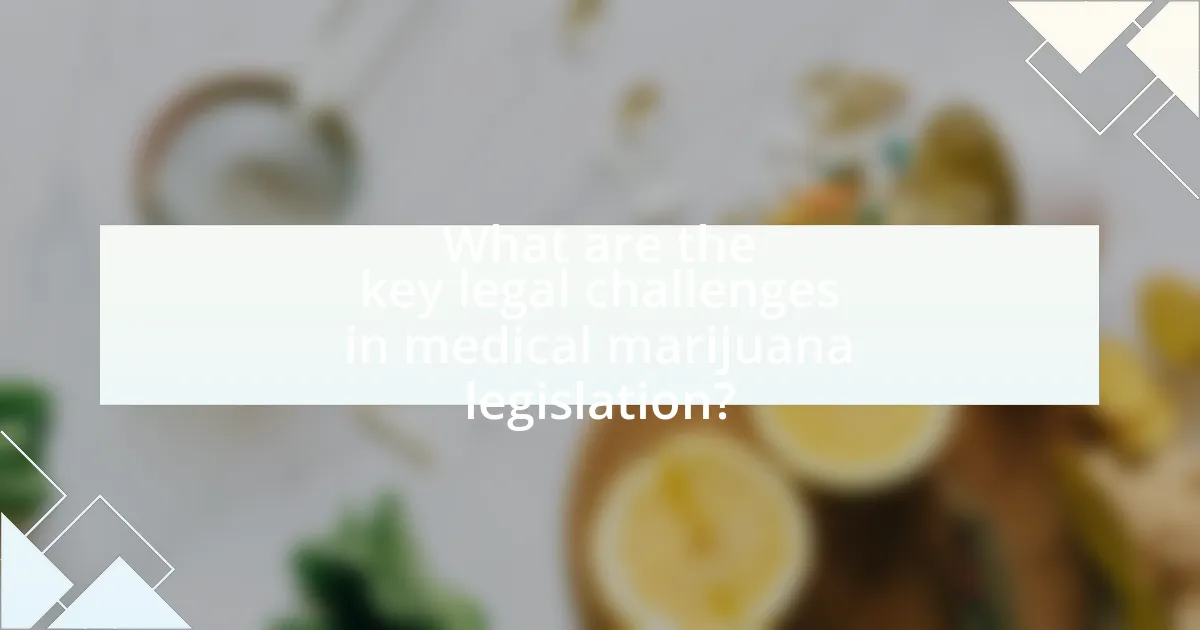The article focuses on the legal challenges surrounding medical marijuana legislation, emphasizing the conflicts between federal and state laws, regulatory compliance issues, and the impact of zoning laws on dispensaries. It outlines how federal regulations, particularly the Controlled Substances Act, create barriers for state programs and advocates, while also discussing the role of public perception and stigma in shaping legislative outcomes. Additionally, the article highlights effective advocacy strategies, including coalition building, grassroots mobilization, and the use of data to influence policymakers, ultimately providing a comprehensive overview of the complexities involved in navigating the legal landscape of medical marijuana.

What are the key legal challenges in medical marijuana legislation?
The key legal challenges in medical marijuana legislation include federal prohibition, state-federal conflicts, regulatory compliance, and access to banking services. Federal prohibition under the Controlled Substances Act classifies marijuana as a Schedule I substance, creating a significant barrier for states attempting to implement medical marijuana programs. This conflict leads to legal uncertainties for patients and providers, as state laws may not align with federal regulations. Additionally, regulatory compliance issues arise from varying state laws regarding cultivation, distribution, and patient access, complicating the legal landscape. Furthermore, the lack of access to banking services for marijuana-related businesses due to federal restrictions poses financial challenges, hindering the growth and stability of the medical marijuana industry.
How do federal laws impact state medical marijuana programs?
Federal laws significantly impact state medical marijuana programs by classifying marijuana as a Schedule I controlled substance under the Controlled Substances Act, which creates legal conflicts for states that have legalized its medical use. This federal classification leads to challenges such as limited access to banking services for marijuana businesses, potential federal enforcement actions against state-licensed operations, and restrictions on research funding related to cannabis. For instance, despite state laws permitting medical marijuana, federal authorities can still prosecute individuals and businesses involved in its distribution, as seen in various cases where federal raids targeted state-compliant dispensaries.
What specific federal regulations affect medical marijuana use?
The specific federal regulations that affect medical marijuana use include the Controlled Substances Act (CSA), which classifies marijuana as a Schedule I substance, thereby prohibiting its use, distribution, and possession under federal law. This classification indicates that marijuana is considered to have a high potential for abuse and no accepted medical use, which directly impacts the legality of medical marijuana programs across states. Additionally, the Cole Memorandum, issued in 2013, provided guidance to federal prosecutors on prioritizing enforcement against marijuana-related activities that violate state laws, although it was rescinded in 2018, creating uncertainty for state-legal medical marijuana operations. Furthermore, the Rohrabacher-Farr Amendment, which has been included in federal spending bills, prohibits the Department of Justice from using funds to interfere with state medical marijuana laws, offering some protection to state programs. These regulations collectively shape the legal landscape for medical marijuana use in the United States.
How do state laws vary in response to federal regulations?
State laws vary in response to federal regulations primarily through the adoption, modification, or rejection of federal standards based on local priorities and public opinion. For instance, while federal law classifies marijuana as a Schedule I substance under the Controlled Substances Act, many states have enacted laws permitting medical and recreational use, reflecting a divergence from federal policy. This variation is evident in states like California and Colorado, which have legalized medical marijuana despite federal prohibition, demonstrating a state-level prioritization of public health and economic benefits over federal restrictions. Additionally, states may implement stricter regulations than federal standards, such as age restrictions or licensing requirements, further illustrating the flexibility of state laws in response to federal regulations.
What are the common legal obstacles faced by advocates?
Advocates for medical marijuana legislation commonly face legal obstacles such as restrictive state laws, federal prohibition, and regulatory uncertainty. Restrictive state laws can limit the scope of advocacy efforts, as many states have varying degrees of acceptance and regulation regarding medical marijuana. Federal prohibition creates a significant barrier, as marijuana remains classified as a Schedule I substance under the Controlled Substances Act, complicating legal advocacy and enforcement. Additionally, regulatory uncertainty arises from inconsistent policies at both state and federal levels, making it challenging for advocates to navigate the legal landscape effectively. These obstacles hinder the ability of advocates to promote and implement medical marijuana legislation successfully.
How do zoning laws affect medical marijuana dispensaries?
Zoning laws significantly impact medical marijuana dispensaries by regulating where they can be located. These laws determine the geographical areas in which dispensaries can operate, often restricting them to specific zones such as commercial or industrial districts while prohibiting them in residential areas. For instance, in many jurisdictions, dispensaries must comply with distance requirements from schools, parks, and other sensitive locations, which can limit their accessibility and viability. Additionally, local governments may impose specific operational conditions, such as hours of operation and signage restrictions, further influencing the business environment for dispensaries. This regulatory framework is crucial as it shapes the market dynamics and accessibility of medical marijuana for patients, reflecting the broader legal landscape surrounding cannabis legislation.
What role do local governments play in medical marijuana legislation?
Local governments play a crucial role in medical marijuana legislation by establishing local regulations, zoning laws, and licensing requirements that govern the cultivation, distribution, and use of medical marijuana within their jurisdictions. These local regulations can significantly influence the accessibility and availability of medical marijuana, as they determine where dispensaries can operate and under what conditions. For example, in states like California, local governments have the authority to impose stricter regulations than state laws, leading to variations in medical marijuana access across different municipalities. This local control is essential because it allows communities to address specific needs and concerns related to medical marijuana, reflecting the values and priorities of their residents.
Why is public perception important in legal advocacy for medical marijuana?
Public perception is crucial in legal advocacy for medical marijuana because it influences policymakers and legislative outcomes. When the public supports medical marijuana, legislators are more likely to introduce and pass favorable laws, as seen in states where public opinion polls show majority support leading to legalization efforts. For instance, a 2021 Gallup poll indicated that 68% of Americans favor legalizing marijuana, reflecting a significant shift in societal attitudes that has prompted legislative changes across various states. This correlation between public sentiment and legislative action underscores the importance of advocacy efforts that aim to educate and shift perceptions to create a conducive environment for legal reforms.
How does stigma influence legislative outcomes?
Stigma significantly influences legislative outcomes by shaping public perception and political discourse surrounding issues like medical marijuana. When stigma is prevalent, lawmakers may hesitate to support legislation due to fear of backlash from constituents or political allies, which can lead to stalled or rejected bills. For instance, research from the National Institute on Drug Abuse indicates that negative perceptions of marijuana use can hinder legislative progress, as seen in states where public opinion remains largely opposed to legalization. This stigma can create a barrier to evidence-based policymaking, as legislators may prioritize political expediency over scientific research and public health considerations.
What strategies can be used to shift public opinion?
To shift public opinion on medical marijuana legislation, advocacy groups can employ strategies such as targeted education campaigns, coalition building, and leveraging social media. Targeted education campaigns inform the public about the benefits and safety of medical marijuana, utilizing data from studies like the 2017 National Academies of Sciences report, which found substantial evidence that cannabis can alleviate chronic pain and improve quality of life. Coalition building involves uniting diverse stakeholders, including healthcare professionals, patients, and legal experts, to present a unified front that emphasizes the medical benefits and necessity of legislation. Leveraging social media allows for rapid dissemination of information and personal stories that resonate with the public, as seen in successful campaigns that have shifted perceptions in states like California and Colorado. These strategies collectively create a more informed and supportive public, ultimately influencing legislative outcomes.

What advocacy strategies can be employed to navigate legal challenges?
Advocacy strategies to navigate legal challenges in medical marijuana legislation include coalition building, public education campaigns, and legal research. Coalition building involves forming alliances with stakeholders such as healthcare professionals, patients, and advocacy groups to create a unified front that can influence policymakers. Public education campaigns aim to inform the public and legislators about the benefits and safety of medical marijuana, thereby shifting public perception and garnering support. Legal research is essential to identify existing laws, precedents, and potential legal hurdles, enabling advocates to craft informed strategies that address specific legal challenges. These strategies have been effective in various states, as evidenced by the successful legalization efforts in states like California and Colorado, where organized advocacy led to significant legislative changes.
How can grassroots movements influence medical marijuana legislation?
Grassroots movements can significantly influence medical marijuana legislation by mobilizing public support and advocating for policy changes at local, state, and national levels. These movements often raise awareness about the benefits of medical marijuana through community education, personal testimonies, and organized campaigns, which can shift public opinion and pressure lawmakers to consider reform. For instance, the successful legalization of medical marijuana in states like California in 1996 was largely driven by grassroots efforts that highlighted patient needs and medical research, demonstrating the power of organized advocacy in shaping legislative outcomes.
What are effective tactics for mobilizing community support?
Effective tactics for mobilizing community support include building coalitions, engaging in grassroots organizing, and utilizing social media campaigns. Building coalitions with local organizations and stakeholders enhances credibility and broadens outreach, as evidenced by successful advocacy efforts in various social movements. Grassroots organizing fosters personal connections and empowers community members to take action, which has been shown to increase participation rates in initiatives. Social media campaigns amplify messages and mobilize supporters quickly, as demonstrated by the rapid spread of information during the legalization efforts in states like Colorado and California. These tactics collectively create a strong foundation for community engagement and support in advocacy efforts.
How can social media be leveraged for advocacy?
Social media can be leveraged for advocacy by creating awareness, mobilizing supporters, and facilitating communication around medical marijuana legislation. Platforms like Twitter and Facebook allow advocates to share information, personal stories, and research findings that highlight the benefits and necessity of medical marijuana. For instance, a study by the Pew Research Center found that 69% of adults in the U.S. use social media, making it an effective tool for reaching a broad audience. Additionally, social media campaigns can encourage grassroots movements, enabling individuals to connect and organize events, petitions, or lobbying efforts, thereby amplifying their collective voice in the legislative process.
What role do partnerships play in advocacy efforts?
Partnerships play a crucial role in advocacy efforts by enhancing resource sharing, expanding outreach, and increasing credibility. In the context of medical marijuana legislation, collaborations between advocacy groups, healthcare professionals, and legal experts can amplify the message and mobilize support more effectively. For instance, a study by the American Medical Association found that coalitions involving diverse stakeholders were more successful in influencing policy changes compared to isolated efforts. This demonstrates that partnerships not only strengthen advocacy campaigns but also facilitate a more comprehensive approach to addressing legal challenges in medical marijuana legislation.
How can coalitions enhance the effectiveness of advocacy campaigns?
Coalitions enhance the effectiveness of advocacy campaigns by uniting diverse stakeholders to amplify their collective voice and resources. This collaboration allows for a broader reach and increased credibility, as multiple organizations can share expertise, data, and networks. For instance, in the context of medical marijuana legislation, coalitions can bring together patient advocacy groups, healthcare professionals, and legal experts to present a unified front, thereby influencing policymakers more effectively. Research shows that campaigns supported by coalitions are often more successful in achieving legislative goals, as they can mobilize larger audiences and create more comprehensive strategies that address various aspects of the issue.
What types of organizations should advocates collaborate with?
Advocates should collaborate with healthcare organizations, legal advocacy groups, and community-based organizations. Healthcare organizations can provide medical expertise and support for the legitimacy of medical marijuana, while legal advocacy groups can assist in navigating the complex legal landscape surrounding marijuana legislation. Community-based organizations can help mobilize grassroots support and raise awareness among the public. Collaborating with these types of organizations enhances the effectiveness of advocacy efforts by leveraging diverse resources and expertise.
How can data and research support advocacy for medical marijuana?
Data and research can support advocacy for medical marijuana by providing evidence of its therapeutic benefits and safety profile. For instance, studies published in journals such as the Journal of the American Medical Association have shown that medical marijuana can effectively alleviate chronic pain, reduce nausea in chemotherapy patients, and improve appetite in individuals with HIV/AIDS. Additionally, a report from the National Academies of Sciences, Engineering, and Medicine concluded that there is substantial evidence that cannabis is effective for treating chronic pain in adults. This empirical evidence strengthens advocacy efforts by demonstrating the medical efficacy of marijuana, thereby influencing public opinion and legislative decisions.
What types of studies are most persuasive in legislative discussions?
Empirical studies that provide quantitative data and systematic reviews of clinical outcomes are the most persuasive in legislative discussions. These types of studies, such as randomized controlled trials and meta-analyses, offer robust evidence that can influence policymakers by demonstrating the efficacy and safety of medical marijuana. For instance, a systematic review published in the Journal of the American Medical Association found that cannabinoids are effective for chronic pain management, which can directly impact legislative decisions regarding medical marijuana use.
How can advocates effectively present data to lawmakers?
Advocates can effectively present data to lawmakers by utilizing clear, concise visuals and relatable narratives that highlight the impact of medical marijuana legislation. For instance, presenting statistics on patient outcomes, such as a 2019 study published in the Journal of Pain Research, which found that 94% of patients reported reduced pain after using medical marijuana, can provide compelling evidence. Additionally, using infographics to illustrate trends in public support or economic benefits, such as tax revenue generated from legalized medical marijuana, can enhance understanding and retention of the information. Engaging lawmakers with personal stories from constituents who have benefited from medical marijuana can further humanize the data, making it more persuasive.

What are the best practices for successful advocacy in medical marijuana legislation?
Successful advocacy in medical marijuana legislation involves building a coalition of stakeholders, including patients, healthcare professionals, and legal experts, to create a unified front. Engaging in grassroots mobilization is essential, as demonstrated by the 2016 California Proposition 64 campaign, which effectively utilized social media and community outreach to inform and rally support. Additionally, providing clear, evidence-based information about the benefits and safety of medical marijuana can counteract misinformation; for instance, studies from the National Academies of Sciences, Engineering, and Medicine have shown that cannabis can alleviate chronic pain and improve quality of life for patients with certain conditions. Lastly, maintaining open communication with legislators and being prepared to address their concerns can facilitate a more favorable legislative environment.
How can advocates effectively communicate their message?
Advocates can effectively communicate their message by utilizing clear, concise language and tailoring their communication to the audience’s values and concerns. This approach ensures that the message resonates and is easily understood. For instance, studies show that framing medical marijuana as a public health issue rather than a legal one can increase support among healthcare professionals and policymakers. Additionally, employing storytelling techniques can humanize the issue, making it relatable and impactful. Research from the American Public Health Association indicates that personal narratives significantly enhance engagement and understanding in advocacy efforts.
What key points should be included in advocacy messaging?
Key points in advocacy messaging for medical marijuana legislation should include clear objectives, factual information, emotional appeal, and calls to action. Clear objectives define the specific goals of the advocacy effort, such as promoting legalization or improving access to medical marijuana. Factual information provides evidence-based data, such as statistics on medical marijuana’s efficacy in treating certain conditions, which can enhance credibility. Emotional appeal connects with the audience on a personal level, sharing stories of individuals who have benefited from medical marijuana, thereby humanizing the issue. Calls to action encourage the audience to engage, whether by contacting legislators, attending events, or sharing information on social media. These elements collectively strengthen the advocacy message and increase its impact.
How can storytelling enhance advocacy efforts?
Storytelling can enhance advocacy efforts by creating emotional connections that resonate with audiences, making complex issues more relatable and understandable. For instance, personal narratives from patients who have benefited from medical marijuana can humanize the legislative debate, illustrating its real-world impact. Research shows that stories can increase empathy and engagement; a study published in the journal “Health Communication” found that narratives significantly improved attitudes toward health-related issues. By leveraging storytelling, advocates can effectively mobilize support and influence public opinion, ultimately driving legislative change.
What are the common pitfalls to avoid in advocacy campaigns?
Common pitfalls to avoid in advocacy campaigns include lack of clear messaging, insufficient stakeholder engagement, and failure to understand the legal landscape. Clear messaging is crucial; without it, the campaign may confuse or alienate potential supporters. Insufficient stakeholder engagement can lead to missed opportunities for collaboration and support, which are vital for success. Additionally, failing to understand the legal landscape can result in strategies that are not compliant with existing laws, jeopardizing the campaign’s credibility and effectiveness. For instance, a study by the National Organization for the Reform of Marijuana Laws highlights that advocacy efforts often falter when they do not align with local regulations, leading to ineffective outreach and wasted resources.
How can advocates ensure they remain compliant with existing laws?
Advocates can ensure compliance with existing laws by regularly reviewing and understanding the legal framework surrounding medical marijuana legislation. This involves staying informed about state and federal regulations, as laws can vary significantly across jurisdictions. For instance, the National Conference of State Legislatures provides updates on state laws, which can help advocates track changes and ensure their strategies align with current legal standards. Additionally, consulting with legal experts in cannabis law can provide clarity on complex legal issues and help advocates navigate potential pitfalls.
What strategies can prevent backlash from opponents?
To prevent backlash from opponents in the context of advocating for medical marijuana legislation, advocates should employ strategies such as building broad coalitions, engaging in transparent communication, and providing evidence-based information. Building coalitions with diverse stakeholders, including healthcare professionals, patients, and community leaders, fosters a united front that can mitigate opposition. Transparent communication about the benefits and regulations of medical marijuana helps to dispel myths and reduce fear among opponents. Additionally, presenting evidence-based research, such as studies demonstrating the medical benefits of marijuana, can counteract negative perceptions and provide a factual basis for support. For instance, a study published in the Journal of Pain Research found that medical marijuana significantly reduces chronic pain, which can be a compelling argument for its legalization.
What practical steps can advocates take to prepare for legislative sessions?
Advocates can prepare for legislative sessions by conducting thorough research on proposed bills and understanding the legislative process. This involves reviewing the text of the legislation, analyzing its implications for medical marijuana policies, and identifying key stakeholders and decision-makers involved in the process. Additionally, advocates should develop a clear messaging strategy that articulates the benefits of the legislation, supported by data and case studies demonstrating successful medical marijuana programs in other jurisdictions. Engaging with constituents to gather support and mobilizing grassroots efforts can further strengthen their position. According to a report by the National Conference of State Legislatures, effective advocacy often includes building coalitions with other organizations to amplify their voice and influence.
How can advocates build relationships with lawmakers before sessions?
Advocates can build relationships with lawmakers before sessions by engaging in consistent communication and establishing trust. Regularly attending town hall meetings, participating in community events, and scheduling one-on-one meetings with lawmakers allow advocates to present their perspectives and concerns directly. Research indicates that personal interactions significantly enhance rapport; for instance, a study by the National Conference of State Legislatures found that lawmakers are more likely to support initiatives from constituents they know personally. Additionally, providing lawmakers with well-researched information and data on medical marijuana legislation can demonstrate the advocate’s commitment and expertise, further solidifying the relationship.
What resources are available for ongoing education and support in advocacy?
Resources available for ongoing education and support in advocacy include organizations such as the National Organization for the Reform of Marijuana Laws (NORML), which provides educational materials and training for advocates. Additionally, the Marijuana Policy Project (MPP) offers resources and support for legislative advocacy, including toolkits and guides. The American Civil Liberties Union (ACLU) also provides information on legal rights and advocacy strategies related to marijuana legislation. These organizations have established credibility through years of advocacy work and provide concrete tools and resources to empower individuals in their advocacy efforts.

Leave a Reply